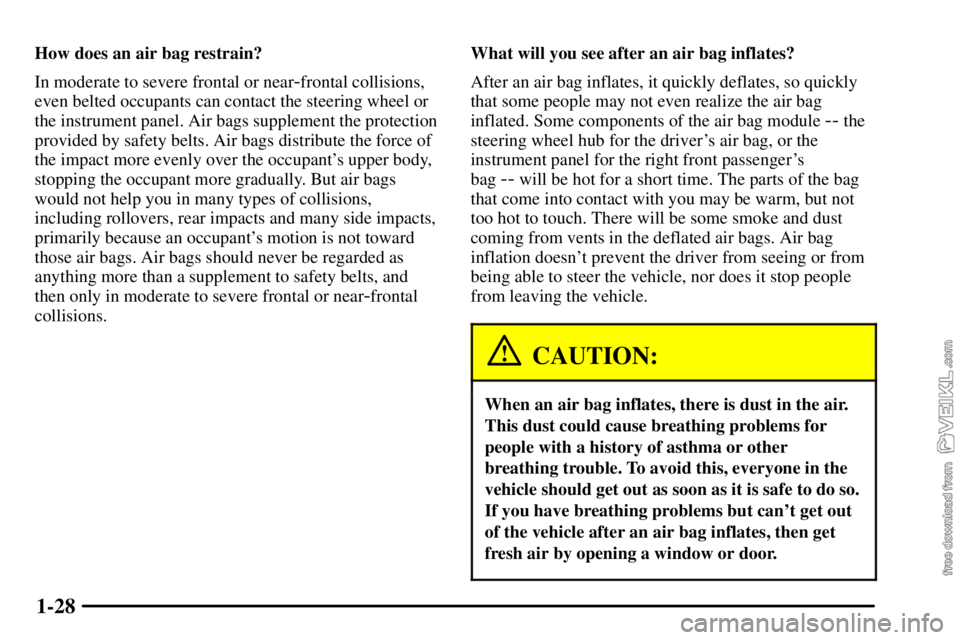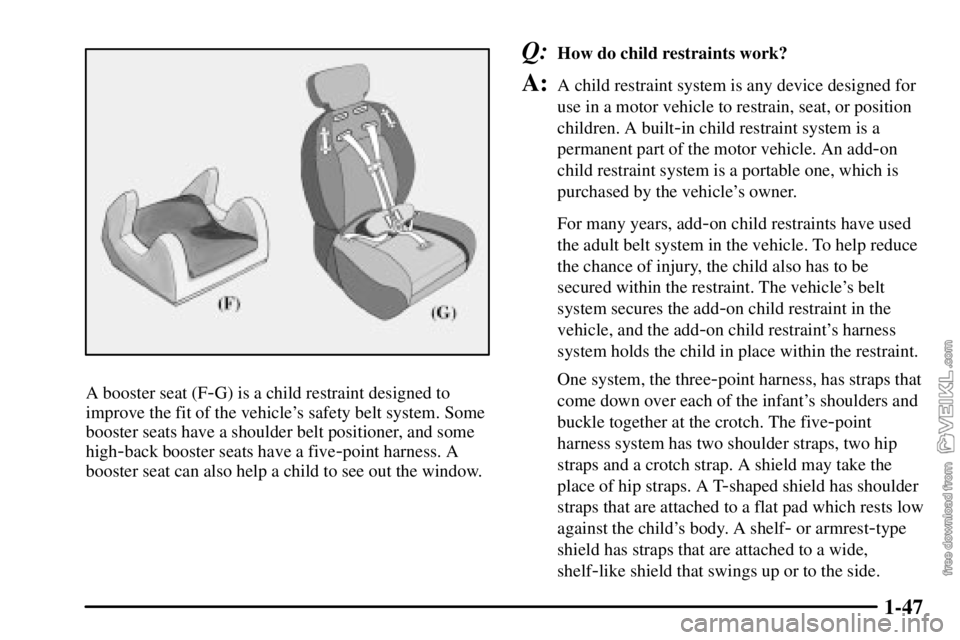Page 35 of 386

1-28
How does an air bag restrain?
In moderate to severe frontal or near
-frontal collisions,
even belted occupants can contact the steering wheel or
the instrument panel. Air bags supplement the protection
provided by safety belts. Air bags distribute the force of
the impact more evenly over the occupant's upper body,
stopping the occupant more gradually. But air bags
would not help you in many types of collisions,
including rollovers, rear impacts and many side impacts,
primarily because an occupant's motion is not toward
those air bags. Air bags should never be regarded as
anything more than a supplement to safety belts, and
then only in moderate to severe frontal or near
-frontal
collisions.What will you see after an air bag inflates?
After an air bag inflates, it quickly deflates, so quickly
that some people may not even realize the air bag
inflated. Some components of the air bag module
-- the
steering wheel hub for the driver's air bag, or the
instrument panel for the right front passenger's
bag
-- will be hot for a short time. The parts of the bag
that come into contact with you may be warm, but not
too hot to touch. There will be some smoke and dust
coming from vents in the deflated air bags. Air bag
inflation doesn't prevent the driver from seeing or from
being able to steer the vehicle, nor does it stop people
from leaving the vehicle.
CAUTION:
When an air bag inflates, there is dust in the air.
This dust could cause breathing problems for
people with a history of asthma or other
breathing trouble. To avoid this, everyone in the
vehicle should get out as soon as it is safe to do so.
If you have breathing problems but can't get out
of the vehicle after an air bag inflates, then get
fresh air by opening a window or door.
Page 45 of 386
1-38
Lap-Shoulder Belt
The positions next to the windows have lap
-shoulder
belts. Here's how to wear one properly.
1. Pick up the latch plate and pull the belt across you.
Don't let it get twisted.
The shoulder belt may lock if you pull the belt across
you very quickly. If this happens, let the belt go back
slightly to unlock it. Then pull the belt across you
more slowly.2. Push the latch plate into the buckle until it clicks.
Pull up on the latch plate to make sure it is secure.
When the shoulder belt is pulled out all the way, it will
lock. If it does, let it go back all the way and start again. If
the belt is not long enough, see ªSafety Belt Extenderº at
the end of this section. Make sure the release button on
the buckle is positioned so you would be able to unbuckle
the safety belt quickly if you ever had to.
3. To make the lap part tight, pull down on the buckle
end of the belt as you pull up on the shoulder part.
Page 46 of 386
1-39
The lap part of the belt should be worn low and snug on
the hips, just touching the thighs. In a crash, this applies
force to the strong pelvic bones. And you'd be less
likely to slide under the lap belt. If you slid under it, the
belt would apply force at your abdomen. This could
cause serious or even fatal injuries. The shoulder belt
should go over the shoulder and across the chest.
These parts of the body are best able to take belt
restraining forces.
The safety belt locks if there's a sudden stop or a crash,
or if you pull the belt very quickly out of the retractor.
Each position next to the windows has a shoulder belt
height adjuster. Move the shoulder belt adjuster to the
height that is right for you. Adjust the height so that the
shoulder portion of the belt is centered on your shoulder.
The belt should be away from your face and neck, but
not falling off your shoulder.
Page 54 of 386

1-47
A booster seat (F-G) is a child restraint designed to
improve the fit of the vehicle's safety belt system. Some
booster seats have a shoulder belt positioner, and some
high
-back booster seats have a five-point harness. A
booster seat can also help a child to see out the window.
Q:How do child restraints work?
A:A child restraint system is any device designed for
use in a motor vehicle to restrain, seat, or position
children. A built
-in child restraint system is a
permanent part of the motor vehicle. An add
-on
child restraint system is a portable one, which is
purchased by the vehicle's owner.
For many years, add
-on child restraints have used
the adult belt system in the vehicle. To help reduce
the chance of injury, the child also has to be
secured within the restraint. The vehicle's belt
system secures the add
-on child restraint in the
vehicle, and the add
-on child restraint's harness
system holds the child in place within the restraint.
One system, the three
-point harness, has straps that
come down over each of the infant's shoulders and
buckle together at the crotch. The five
-point
harness system has two shoulder straps, two hip
straps and a crotch strap. A shield may take the
place of hip straps. A T
-shaped shield has shoulder
straps that are attached to a flat pad which rests low
against the child's body. A shelf
- or armrest-type
shield has straps that are attached to a wide,
shelf
-like shield that swings up or to the side.
Page 71 of 386
1-64
Older Children
Older children who have outgrown booster seats should
wear the vehicle's safety belts.
If you have the choice, a child should sit next to a
window so the child can wear a lap
-shoulder belt and
get the additional restraint a shoulder belt can provide.
Q:What is the proper way to wear safety belts?
A:If possible, an older child should wear a
lap
-shoulder belt and get the additional restraint a
shoulder belt can provide. The shoulder belt should
not cross the face or neck. The lap belt should fit
snugly below the hips, just touching the top of the
thighs. It should never be worn over the abdomen,
which could cause severe or even fatal internal
injuries in a crash.
Accident statistics show that children are safer if they
are restrained in the rear seat.
In a crash, children who are not buckled up can strike
other people who are buckled up, or can be thrown out
of the vehicle. Older children need to use safety belts
properly.
Page 76 of 386

2-
2-1
Section 2 Features and Controls
Here you can learn about the many standard and optional features on your vehicle, and information on starting,
shifting and braking. Also explained are the instrument panel and the warning systems that tell you if everything is
working properly
-- and what to do if you have a problem.
2
-2 Windows
2-5 Keys
2-7 Door Locks
2-8 Keyless Entry System (If Equipped)
2-12 Switchbanks
2-13 Theft
2-14 New Vehicle ªBreak-Inº
2-15 Ignition Positions
2-16 Starting Your Gasoline Engine
2-19 Starting the Diesel Engine
2-24 Starting Your DURAMAX� Diesel Engine
2-27 Engine Checks Before Operating
2-28 Engine Coolant Heater (If Equipped)
2-30 Diesel Engine Exhaust Brake (If Equipped)
2-31 Two-Speed Rear Axle Electric Shift Control
(If Equipped)
2
-34 Automatic Transmission Operation
2-36 Manual Transmission Operation
2-40 Parking
2-45 Parking Over Things That Burn
2-45 Engine Exhaust2
-46 Running Your Engine While You're Parked
(Automatic Transmission)
2
-47 Horn
2-48 Tilt Wheel (If Equipped)
2-48 Turn Signal/Multifunction Lever
2-55 Inter-Axle Differential Lock Control
(If Equipped)
2
-56 Rear Axle Differential Lock Control
(If Equipped)
2
-57 Exterior Lamps
2-60 Interior Lamps
2-61 Mirrors
2-63 Storage Compartments
2-65 Accessory Power Outlets
2-66 Trailer Connections (C4/C5 Models Only)
(If Equipped)
2
-67 Trailer Connections (C6/C7/C8 Models Only)
(If Equipped)
2
-68 The Instrument Panel-Your
Information System
2
-70 Instrument Panel Cluster
2-73 Warning Lights, Gages and Indicators
Page 77 of 386
2-2
Windows
CAUTION:
Leaving children in a vehicle with the windows
closed is dangerous. A child can be overcome by
the extreme heat and can suffer permanent
injuries or even death from heat stroke. Never
leave a child alone in a vehicle, especially with the
windows closed in warm or hot weather.
Page 78 of 386
2-3 Manual Windows
Turn the hand crank on each door to raise or lower
the window.
Power Windows (If Equipped)
If your vehicle is equipped with power windows, the
switches are located on each of the side doors. The
driver's door also has a switch for the passenger's
window.
If your vehicle is a Crew Cab model with power
windows, there will be switches located on the rear
doors as well.
However, the driver's door will have four switches
located on it that can control all windows.
Your power windows will work when the ignition has
been turned to ACCESSORY or RUN.
Press the rear of the switch with the power window
symbol on it to lower the window and the front of the
switch to raise the window.